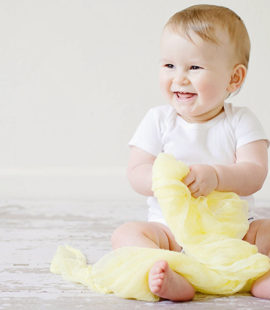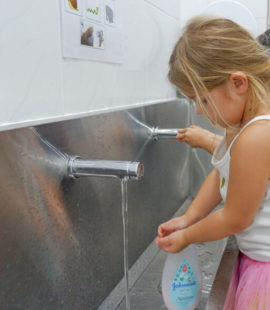KEY STEPS IN POTTY TRAINING SUPPORT
LET YOUR CHILD DO THINGS AT THEIR OWN PACE
Potty training requires patience, perseverance and a sprinkle of good humour. Children typically learn to be potty trained between the ages of 2 and 4, but you must do things at the child’s pace as they first embark upon this learning process.
When is my child ready?
To become potty trained, a child must first learn to control their sphincter. It is only around the age of 2 that a child can recognise the sensation of having “full” organs. The parent’s role is not to “teach,” but rather to support and guide the child through the potty training process. To successfully use the potty, your child must be physically and, more importantly, psychologically prepared. You must therefore trust them.
You may trust them in the following ways:
- They go to their potty themselves and sit on it by themselves.
- They partly undress themselves without your help.
- They remain dry for several hours.
- They tell you when their nappy is dirty (e.g. “wee” or “poo”).
- They are curious about this subject (e.g.: they put their cuddly toy on the potty or they like stories about potty training).
6 KEY STEPS
1/ Don’t force things
The age that potty training is mastered varies from child to child. For this reason, don’t set the age at which you believe your child should be potty trained. Instead, wait for signs of readiness, then do things at their own pace.
2/ Choose the right time for your child
There is no ideal time for potty training, but it’s recommended to start during a peaceful period at home (e.g. don’t do it while you’re moving home or having a baby).
3/ Familiarise them with the potty
Put their potty by the toilet and explain its purpose. Then, invite them to sit on it, even with their clothes on, or to put their cuddly toy on it. It will be like a game at first. Encourage them to do what you do when they have a wee or poo. Praise them every time they try.
4/ Set a routine
Gradually get your child to sit on the potty at regular intervals: when they wake up, after meals and snacks, and before naps, baths and bedtime, but for no longer than 5 minutes at a time. Don’t give them toys or books while they are sitting on the potty, so that they can focus on how their sphincter feels. If nothing happens, let them go back to playing without showing disappointment or making remarks.
5/ Get them to start wearing underwear
If your child starts to use the potty often, don’t put them in a nappy during the day. They will therefore be more motivated to stay dry with cloth or training pants. Put on clothes that are easy to take off and remind them to go to their potty often. At this age, it’s perfectly normal for them to forget to do this, especially if they’re focused on playing, so don’t put too much emphasis on their little accidents, but rather boost their self-esteem by encouraging them again and reminding them of their successes.
6/ Do away with their nappy completely
Do they stay clean all day and their nappy is dry during several naps? If so, then it’s time to get rid of it. You must also apply the same method overnight. Until then, even if you put them in a nappy overnight, encourage them to call you if they want to go to their potty during naptime or in the night.




QUESTIONS RELATING TO THE POTTY TRAINING PROCESS
REMEMBER!
- To learn to be potty trained, a child must be physically and psychologically prepared. This usually occurs between the ages of 2 and 4.
- You shouldn’t force a child to become potty trained, but rather do things at their own pace and trust them.
- If a child wees or poos in their pants, they shouldn’t be told off or punished. If necessary, they should also be able to go back to wearing a nappy without feeling ashamed.
Source : Naître et grandir
Scientific review: Dr. Anne-Claude Bernard-Bonnin, Pediatrician / Researcher and writer: Naître et grandir team


